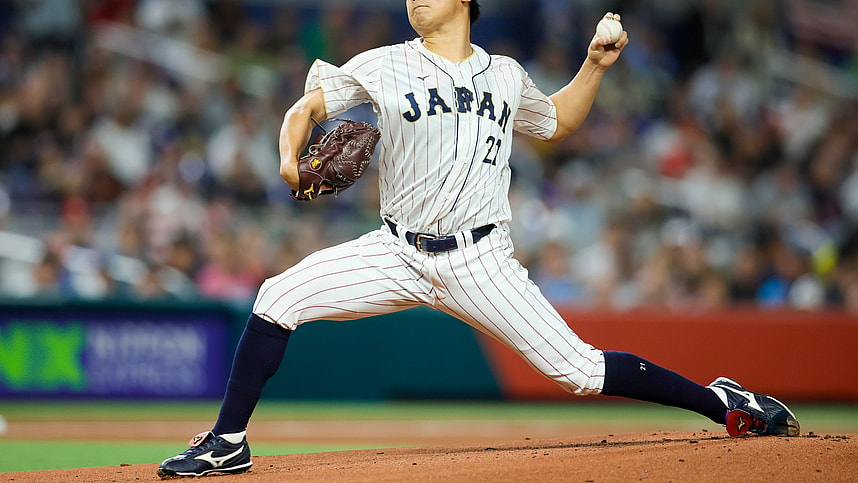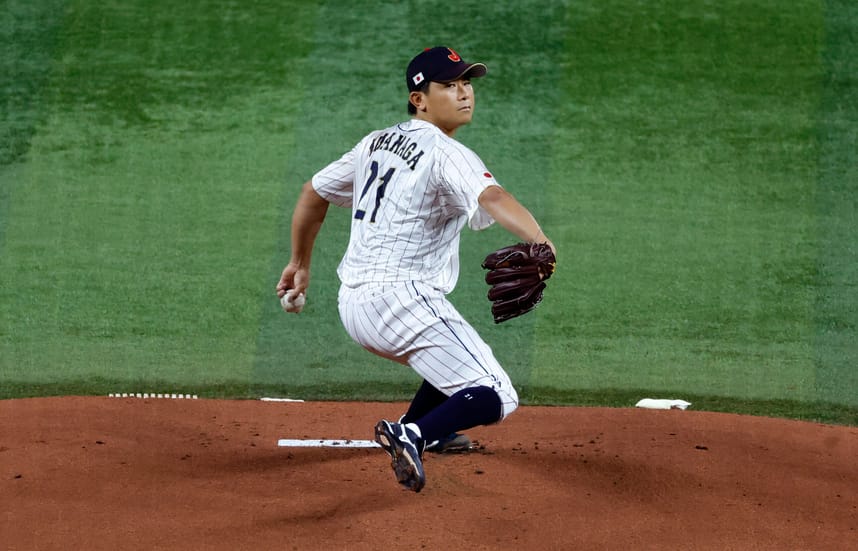
We know one thing about this offseason that’s remained true since the late summer. When Brian Cashman went to Japan, he was expecting to watch a strong outing from star right-hander Yoshinobu Yamamoto, but he was treated to a no-hitter. It bred a photo now made iconic, and that was an image of the Yankees‘ long-time General Manager standing up, clapping behind home plate, but the Yankees are from Yamamoto’s only suitor.
Shota Imanaga is set to be posted, and while not the pitcher that Yamamoto is, the pitch mix is incredible, and he has all the makings of a top starter in this league. The 30-year-old southpaw from Kitakyushu, a city on the Kyushu Island in Japan, has already been scouted by the Yankees and a plethora of other teams, and he could be the best option for a Yankee team looking to make big investments on offense.
One of the Best Pitch Mixes in Japan
Shota Imanaga isn’t as flashy of a name as some of the other top arms to come over from Japan, but his stuff might be some of the best. At just 5’10, he releases from a lower slot than most based on his height, and yet he possesses a four-seam fastball with some of the best vertical ride on the planet. “Ride” pertains to the backspin on a fastball that creates a force opposite to the one gravity imparts on the ball, which reduces drop, allowing it to “ride” through the zone.
We can measure it with Induced Vertical Break, also known as IVB, and when we measure Imanaga’s IVB from the World Baseball Classic, you get some wicked pitches. The WBC baseball closely resembles the MLB ball and actually differs from the ball used in Japan’s Nippon Baseball League, an adjustment many pitchers have trouble with when coming stateside. Imanaga didn’t have any issues with the quality of his pitches, even ripping off a fastball with 25.3″ of IVB, with only 17 pitches being thrown at or above 25″ of IVB this past season.

Imanaga’s fastball to Kyle Schwarber came in at 93.6 MPH with 22.3″ of IVB, and Kyle Schwarber just swings right under it. That’s the effect that a fastball like that has, as hitters struggle to get on top of a ball like that, resulting in weak flyballs and incredible swing-and-miss potential. As mentioned earlier, his smaller frame does create a lower release height, which further adds to the deception, and this was a pitch that graded out with a 143.1 Stuff+ in his small WBC sample size.
Pair that with a sweeping slider and strong splitter, and he has three dominant pitches he can throw in any count and to any batter. He does throw some cutters and curveballs as well, and this is the type of pitcher who could really flourish in the Majors, where there’s a greater emphasis on swing-and-miss and selling out for power. Despite the NPB having lower strikeout rates than we see in the Majors, Imanaga led all of Japan in strikeout rate (29.2%) and strikeout-to-walk rate (25.2%) with his incredible command and arsenal guiding the way.
With a league-best 14% Swinging Strike Rate, Imanaga is arguably the best strikeout pitcher in Japan on a per-rate basis, and the Yankees excel with whiff kings like himself. The profile of a high-flyball pitcher does seem scary, especially when we harken back to the point of reduced strikeouts in Japan, as that also comes with fewer HRs and slugging numbers compared to the Majors. With a 1.03 HR/9 in the NPB, there are questions as to how much that number would spike in the United States, especially at Yankee Stadium.
- The Yankees should not be deterred by Kyle Tucker’s poor market
- The Yankees might have found their next Luke Weaver in $2 million signing
- Yankees predicted to land Bo Bichette but the reason is ludicrous

Say what you want about Nestor Cortes in 2023, who suffered through a myriad of injuries all season, but the Yankees have turned him completely around. They’ve got a 3.09 ERA in 314.2 innings since his return in 2021, and the fastball he possesses is very similar to the one thrown by Imanaga. What made Cortes so good in 2022 was a four-seamer with +22 Run Value, making it one of the best pitches in all of baseball last season. Knowing that both Imanaga and Cortes possess similar fastballs in terms of shape, the organization has familiarity with improving arms like Shota.
His cutter isn’t a plus pitch, and he relied on it a lot less this past season to great success, but the fastball seems to be his key. The sweeper plays as a whiff pitch against left-handers and something he can land against righties depending on the matchup as well, but his splitter is what you look at as his reliable secondary against right-handers.

Those three pitches alone would be enough for a dominant arsenal, but throw in a curveball and cutter as well, and you’ve got the pitch mix that led the entire World Baseball Classic in Stuff+ (min. 28 pitches per appearance). If you like nasty stuff and whiffs, you’ll love Imanaga, but should the Yankees go for Plan B in a market that has a clearly-coveted Plan A?
Why the Yankees Could Go With Shota Imanaga

Let’s make one thing clear; Yoshinobu Yamamoto is the better pitcher and will get paid more money as a result. There is a world in their plausible range of outcomes that allows Imanaga to have a better career, but the talent gap and upside clearly favor the 25-year-old righthander. The Yankees, who are the highest-valued franchise in sports, should simply just sign the best players available, but that’s not how baseball works, and that’s not how the Yankees are operating in the present day.
If the Yankees need to pick between extending Juan Soto and signing Yoshinobu Yamamoto, the choice isn’t hard, and when looking at secondary options on this market, it’s hard to find a suitable #2 or #3 starter without shelling out a ton of money. Imanaga isn’t going to come cheap, likely commanding a multi-year deal of around $15 million a season annually. I think the Kodai Senga deal is a good benchmark, with the same age at the time of signing and both having strong upside.
A five-year $80 million deal would be a good ballpark estimate, and the Yankees could leave themselves open to a flurry of moves even after signing Imanaga. Looking at the rotation, they’d be loaded with high-upside arms who could further bolster the Yankees’ starting depth.
- Gerrit Cole
- Carlos Rodon
- Shota Imanaga
- Michael King
- Nestor Cortes
- Clarke Schmidt
- Jhony Brito
- Randy Vasquez
If the Yankees also add Frankie Montas, it’ll help keep their rotation stocked with impressive arms and prevent the disasters they had in their rotation this past season. You can never have enough pitching, and by spending roughly $25 million towards the Yankees’ payroll, they could still make a meaningful splash in their offense and use an arm or two in that group of starters to acquire another.
This isn’t a pro-efficiency argument as much as it is one about the Yankees’ spending patterns, and if the Yankees are going to make both a meaningful splash to their offense and get Yoshinobu Yamamoto, they should just do that. What this is saying is that if the Yankees feel less inclined to heavily pursue Yamamoto because of an opportunity to acquire Juan Soto (this is really all about Juan Soto), then they could pivot to Imanaga and still get a meaningful addition to their rotation.
However this offseason shakes up, the team that ends up with this southpaw is going to love the arsenal they get to work with, and by displaying excellent pitch movement with the WBC ball (which closely resembles the Major League one), we could see instant results in 2024, and could rack up plenty of whiffs in the Majors.
More about: New York Yankees